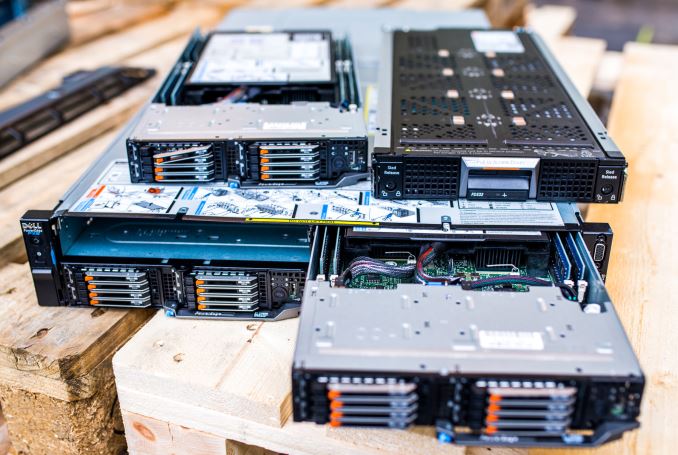The Evolution of HDDs in the Near Future: Speaking with Seagate CTO, Mark Re
by Anton Shilov on July 6, 2016 2:00 PM ESTNew 10K and 15K RPM HDDs Incoming
Hard drives with 10K and 15K spindle speeds are used to store mission-critical applications and data that also require high performance. Such drives typically use a SAS interface with its advantages over SATA/AHCI. Plenty of legacy systems and setups still rely on these fast hard drives, and as a result these systems are not going to be decommissioned in the near future. Nonetheless, the total available market for ultra-fast HDDs with 10K and 15K RPM spindle speeds has shrunk in the recent years due of SSDs. This does not mean that speedy HDDs no longer evolve - Seagate informed us that it is preparing another generation of 10K and 15K RPM HDDs.
Seagate’s new generation of 10K hard drives will not only feature 10K RPM spindle speed as per the name, but also TDMR technology — two readers per head. Those readers will read one track to improve signal to noise ratio and enable higher capacities. Keeping in mind that we are talking about critical storage applications, HDDs with two readers per arm will keep using PMR or SMR recording technology, but eventually the tech could be used for HAMR-based drives.
When it comes to 15K HDDs, Seagate seems to be somewhat more humble or secretive. The company did confirm that it is working on at least one more generation of 15K hard drives. The high-performance SAS deployments are already there and someone needs to serve them, which is where the next-generation 15K HDDs may come in handy. Moreover, SNIA has a long roadmap for SAS towards 24 Gb/s transfer speeds and the year 2020 ahead of it, which is why it is important for Seagate to offer both HDD and SSD solutions for this market. The next generation of 15K HDDs could be the last generation of such hard drives, which is why it will have to offer a balance of features and technologies that Seagate does not want to discuss at this time. Perhaps, not because of competitive reasons, but because it is working with its customers to enable features that they need.
Nonetheless, as new data center platforms arrive, the need for 15K HDDs will inevitably decrease and Seagate understands that. For example, Intel’s latest SSDs for mission-critical applications rely on PCIe bus and NVMe protocol. As a major provider of ultra-high-end Nytro storage accelerators, Seagate will naturally follow market’s trends, but this is a topic to be covered by an SSD-related conversation.











91 Comments
View All Comments
nandnandnand - Wednesday, July 6, 2016 - link
They explained how to mitigate SMR performance issues in the article.romrunning - Wednesday, July 6, 2016 - link
Sure, you can try to mitigate the performance, but I feel the initial performance design should have been aiming higher than existing PMR performance. That's why SMR is disappointing to me. I feel like they were dumping R&D into HAMR, and they weren't getting results as fast as they wanted. So they go the SMR route to get the desired results (more storage density) in the interim.It's not like SSDs. While SSDs were lower in capacity initially, the speed increase was dramatically better. SMR-based drives are only slightly better in capacity, but they are more noticeably worse in performance. Thus it didn't have the same impact - it doesn't have enough of the "wow" speed factor to help overlook its performance shortcomings.
It's like when Honda introduced the new Insight hybrid. It wasn't better or even at the same level of "MPG" as the Prius; that's why it didn't fare well.
JimmiG - Thursday, July 7, 2016 - link
Well, SMR is a stopgap solution, but it's here now and it works. HAMR sounds great on paper, but show me where I can buy an 8 TB HAMR drive today, for under $250?My 8TB Seagate Archive has the lowest cost/GB of any drive at the time, and it works fine as a secondary storage/backup drive. Just manually dumping files to it or running scheduled backups work great, with performance that doesn't really "feel" any different than my 5900 RPM 4 TB PMR drive.
romrunning - Wednesday, July 6, 2016 - link
I also say this coming from someone who liked the Seagate 600 Pro SSD. They could have done a lot more years ago to compete for the market lead in consumer SSDs; basically Samsung dominates right now.StormyParis - Wednesday, July 6, 2016 - link
Even as an individuaI, I mostly don't care about storage performance. OS and apps and "live" data files get an SSD. That <5% of my storage. Media, archives and backups get an HDD. That's >95% of my storage. I don't care about performance for SSD nor HDD, both are OK for the uses I dedicate them too even in their cheapest crappiest incarnations.I'm more interested in cost, space, reliability, and durability.
serendip - Friday, July 8, 2016 - link
Amen to that, beyond the tiny but vocal enthusiast community there are loads of users who want cheap, huge and reliable storage. I hope the SSD and HDD manufacturers don't forget this market and just concentrate on enthusiasts or enterprise customers.paulemannsen - Saturday, July 9, 2016 - link
+1. I could even live with 10/10 mb read/write speeds, just give me more reliability and space.Nozuka - Wednesday, July 6, 2016 - link
There are already 13TB SSDs... currently extremely expensive, but it's only a matter of time...XZerg - Wednesday, July 6, 2016 - link
you mean 16TB - from Samsung - http://gizmodo.com/samsungs-16tb-ssd-is-now-an-act...Lolimaster - Friday, July 8, 2016 - link
The 13TB was from fixstars (japan based). They were the 1st in multiterabyte SSDs 3-6-10-13TB.